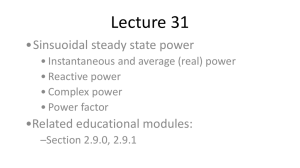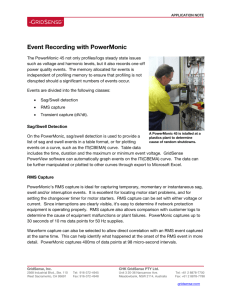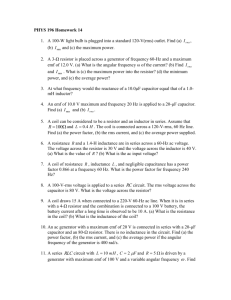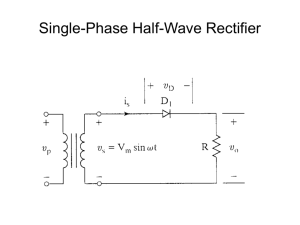Voltage and Current Measurement of Non
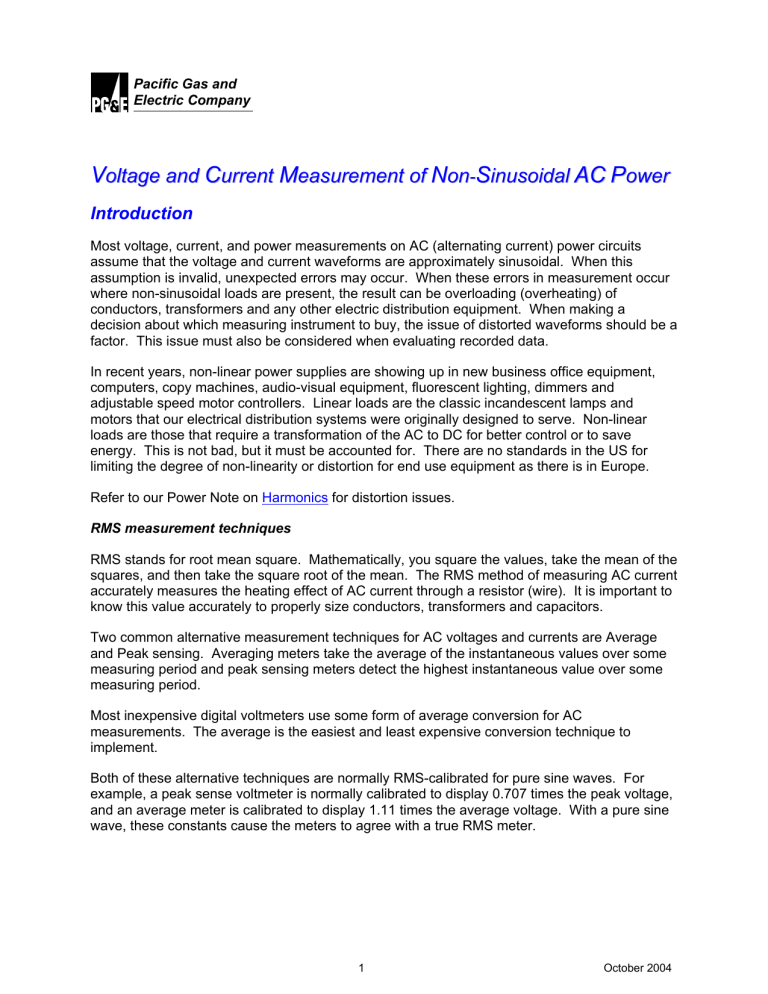
Pacific Gas and
Electric Company
V o l l t t a g e a n d C u r r r r e n t t M e a s u r r e m e n t t o f f N o n S i i n u s o i i d a l l A C P o w e r r
Introduction
Most voltage, current, and power measurements on AC (alternating current) power circuits assume that the voltage and current waveforms are approximately sinusoidal. When this assumption is invalid, unexpected errors may occur. When these errors in measurement occur where non-sinusoidal loads are present, the result can be overloading (overheating) of conductors, transformers and any other electric distribution equipment. When making a decision about which measuring instrument to buy, the issue of distorted waveforms should be a factor. This issue must also be considered when evaluating recorded data.
In recent years, non-linear power supplies are showing up in new business office equipment, computers, copy machines, audio-visual equipment, fluorescent lighting, dimmers and adjustable speed motor controllers. Linear loads are the classic incandescent lamps and motors that our electrical distribution systems were originally designed to serve. Non-linear loads are those that require a transformation of the AC to DC for better control or to save energy. This is not bad, but it must be accounted for. There are no standards in the US for limiting the degree of non-linearity or distortion for end use equipment as there is in Europe.
Refer to our Power Note on Harmonics for distortion issues.
RMS measurement techniques
RMS stands for root mean square. Mathematically, you square the values, take the mean of the squares, and then take the square root of the mean. The RMS method of measuring AC current accurately measures the heating effect of AC current through a resistor (wire). It is important to know this value accurately to properly size conductors, transformers and capacitors.
Two common alternative measurement techniques for AC voltages and currents are Average and Peak sensing. Averaging meters take the average of the instantaneous values over some measuring period and peak sensing meters detect the highest instantaneous value over some measuring period.
Most inexpensive digital voltmeters use some form of average conversion for AC measurements. The average is the easiest and least expensive conversion technique to implement.
Both of these alternative techniques are normally RMS-calibrated for pure sine waves. For example, a peak sense voltmeter is normally calibrated to display 0.707 times the peak voltage, and an average meter is calibrated to display 1.11 times the average voltage. With a pure sine wave, these constants cause the meters to agree with a true RMS meter.
Refer to Table 1 for a comparison of measurement techniques for various waveforms.
Table 1 - Comparison of conversion techniques for AC current measurements.
All readings are normalized to read 100.0 Amps on an average converting,
RMS-calibrated meter - the most common kind of current meter.
True RMS Conversion Techniques.
There are three true RMS conversion techniques in common use today: thermal, analog, and digital.
In the thermal true RMS conversion , the input signal is used to heat a resistive load, and the amount of heat is directly proportional to the RMS value of the signal. This is generally the most precise technique. However, it has an extremely long time constant, on the order of minutes, making it impractical for most power measurements in the field. Some utilities in Canada use this method in their revenue meters for large customers. It has another disadvantage which is the requirement to frequently calibrate for accuracy.
Analog true RMS converters use circuits to take the logarithm of the input voltage (or current), double it, average it, and then take the anti-log of half the average. This is the equivalent to squaring the voltage, taking the mean of the squares, then taking the square root of the mean.
The time constant of the conversion is set by the averaging circuit, and can typically be adjusted from a few milliseconds to several hundred milliseconds. Longer time constants give less ripple on the output signal, but lead to poor response with rapid, short-term changes in the input signal, an important concern in computer power. Analog converters also have limits on slew rates and crest factor, but these limits are rarely a problem for AC power measurements with modern designs.
Digital true RMS converters sample the input signal at a high rate and convert the samples to digital values. Typically, the sampling rate is over a 100 times the anticipated signal frequency.
If we are measuring 60Hz power then we would be sampling at a rate of over 6000Hz. A processor squares each value, sums the square along with some number of previously squared samples, and takes the square root of the sum. This gives a precise, true RMS conversion on any arbitrary waveform, and the time constant of the conversion can be adjusted arbitrarily by adjusting the number of previously squared samples. The IEEE1159 standard on monitoring power states that the minimum period to measure the RMS value is ½ cycle, but common convention is to use one cycle as the minimum. It is beyond the capability of most available power monitors to perform this level of mathematics continuously, so they use a variety of periodic sampling techniques. Sometimes these periodic sampling rates can be user programmable. Another limiting concern is the amount of memory required to store these values.
Potential Source of Errors
Frequency response errors in current measurements.
Even when the processor makes an accurate calculation of the data, the measurement can be in error due to limits of the current transducer used to gather the current values. Current measurements on AC circuits are generally taken with some form of current transformer.
Current transformers have limited bandwidth, which is not generally a concern on sinusoidal AC power waveforms. However, with non-linear loads, both ends of the pass band become critical.
Therefore, it is important to know the limits of the current transducers employed. Bandwidth problems in current transformers can be eliminated by replacing them with resistive shunts or with Hall-effect devices.
Phase shift errors in current measurements.
In addition to introducing band-pass errors, current transformers generally introduce phase-shift errors which vary with frequency. Frequency-varying phase shifts can introduce substantial errors in wave-shape measurements. These phase shift errors are generally small at low-order harmonics, but can become large at higher-order harmonics. For these reasons, it is important to require laboratory test results for current transformers that give both band-width frequency response accuracy and phase shift response for all the harmonic frequencies of interest.
Power Factor Measurement Techniques.
Power factor, the ratio of real power to apparent power, has traditionally been measured by examining the phase angle between the voltage and current. For non-sinusoidal waveforms, this measurement technique is in error; it always presents a power factor reading which is erroneously high. When there is a high percentage of a non-linear load, the power factor error can be over 50%. The only accurate technique for measuring power factor of non-linear loads is to average the instantaneous power then divide by the product of the true RMS voltage and the true RMS current.
References:
McEachern, Alexander, Voltage, Current, Power Factor, and Spectrum Measurements on Nonsinusoidal AC Power Circuits , October, 1987, Basic Measuring Instruments.
Dugan, R. C., M. F. McGranaghan, S. Santoso, H. W. Beaty, Electrical Power Systems Quality ,
2d edition, McGraw-Hill, New York, 2003, chap. 11.







